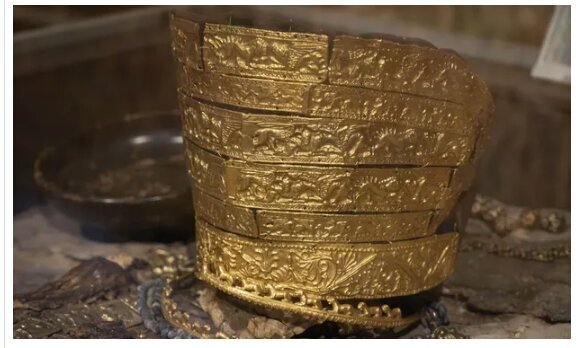Gold treasures of ancient Iranian migrants break out another skirmish between Ukraine, Russia

TEHRAN – Uncertain fate of gold treasures, that once belonged to Scythians, Iranian nomadic people who migrated westward to southern Russia and Ukraine in the 8th and 7th centuries BC, has led to another skirmish between the two neighbors in the wake of the war in Ukraine.
The Scythians founded a rich, powerful empire centered on what is now Crimea. The empire survived for several centuries before succumbing to the Sarmatians during the period from the 4th century BC to the 2nd century CE.
The people the Greeks called Scythians were formidable warriors and nomads who dominated the Eurasian steppe for more than 1,000 years from about 800 BC – long before the creation of national borders.
The fabulous weapons and gold ornaments they left behind ended up in museums across the region, many of them in Ukraine.
According to The Guardian, since Russian troops invaded Ukraine in February, however, much Scythian gold – along with millions of other priceless artifacts – has been looted or “evacuated.”
Serhii Telizhenko, of the National Institute of Archaeology in Kyiv, who has been monitoring the wave of destruction, said he realized there would be losses after the invasion, “but I could not imagine the scale.”
As mentioned by The Guardian, some museums managed to move their collections to safety in time. They include Odesa’s archaeological museum and one in Melitopol that holds Ukraine’s most important collection of Scythian gold. Meanwhile, Irina Shramko, director of Kharkiv’s archaeological museum, and her colleagues have been spending their nights close to their Scythian and bronze age treasures.
“This is the case all over Ukraine,” said Regina Uhl of the German Archaeological Institute in Berlin, which has been providing money and materials for its Ukrainian colleagues. “They thought they could protect the objects better if they were closer.”
However, the pace of Russian occupation, particularly in the east of the country, meant that many museums did not have time to implement their evacuation plans. The local history museums of Lyman in the Donetsk region and Rubizhne in Luhansk were destroyed, Telizhenko said, and the fate of their collections is unknown.
The museum of local lore in Mariupol, which also had an important collection of Scythian gold, was badly shelled in the spring, and in April Russian media announced that about 2,000 objects had been removed from it to the occupied city of Donetsk. They include priceless paintings by Arkhip Kuindzhi and Ivan Aivazovsky.
Ukrainian intelligence claims that much of the material taken from its museums has found its way to Crimea. Telizhenko cited reports that in late October, employees of the Chersonese state museum in Sevastopol, Crimea, arrived at the Kherson regional museum of local lore to remove its collection.
Sam Hardy, head of illicit trade research at international charity, the Heritage Management Organization, said the loss of ancient sites’ integrity was more serious than the loss of priceless artifacts. “The thing that we get the information from is the context, the relationship between everything, the site rather than the individual object,” he said.
Until the 20th century, most of what was known about the history of the Scythians came from the account of the ancient Greek historian Herodotus, who visited their territory. In modern times, this record has been expanded primarily by Russian and other anthropologists who have dug kurgans in places like Tyva and Kazakhstan.
The Scythians were feared and admired for their prowess in war and especially their horsemanship. They were among the first humans to master the art of horseback riding, and their mobility amazed their neighbors. The migration of the Scythians from Asia eventually brought them into the territory of the Cimmerians, who traditionally controlled the Caucasus and the plains north of the Black Sea.
AFM
Leave a Comment